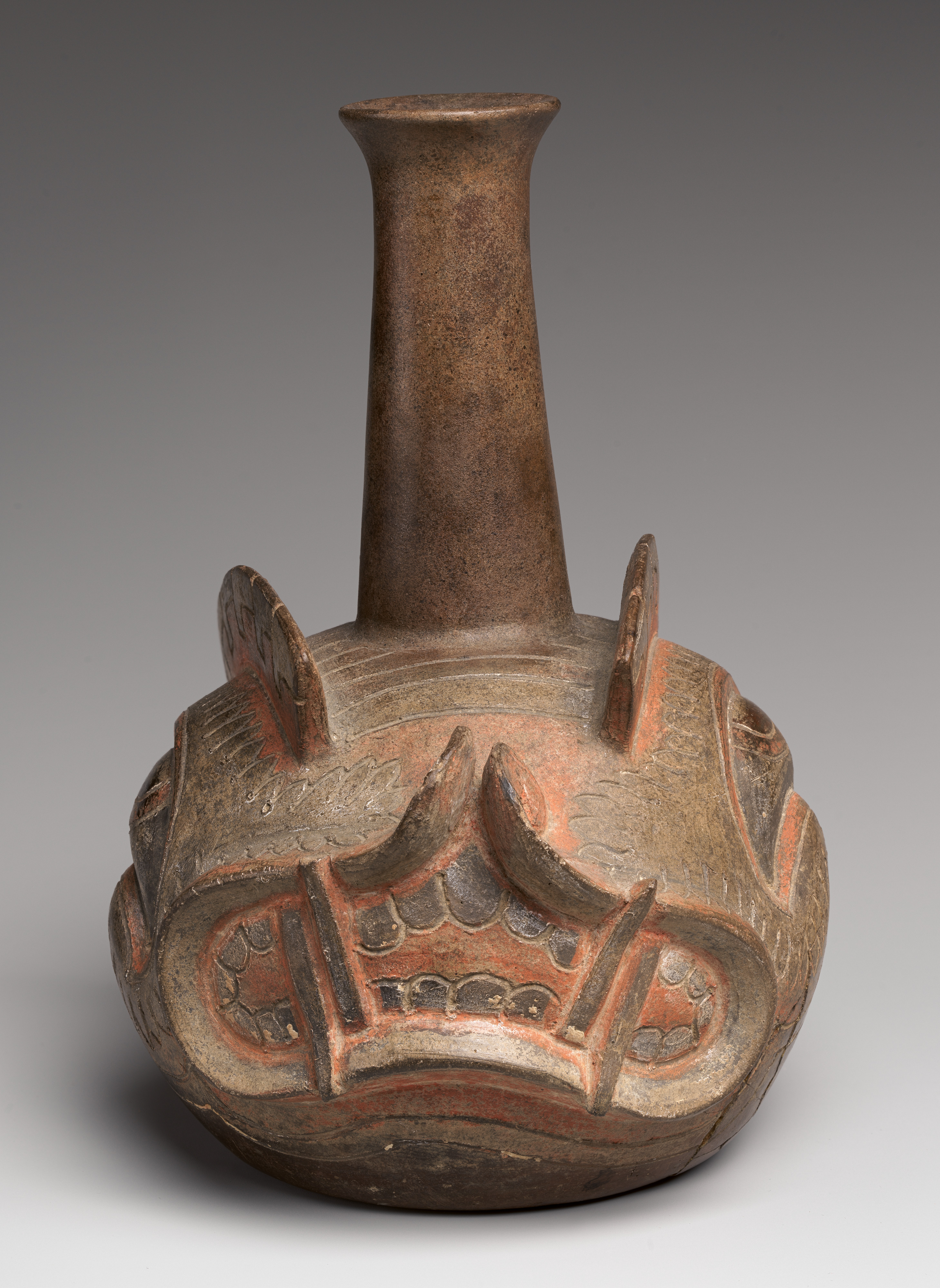Bottle with leaf-nosed bat head
Not on view
Spouted ceramic vessels from the Peruvian Formative period (1800–200 B.C.) were usually designed with elaborately sculpted bodies, such as this bottle in the shape of an animal head with bared teeth. The fanged mouth paired with an upward curled nose is diagnostic of the leaf-nosed bat (Phyllostomidae) commonly found in the Andes. In addition to the nose leaf—a spear-shaped structure on the muzzle—a bat’s ears are a critical tool in their ability to locate objects based on sound (or echolocation). Rendered as three-dimensional crests on either side of the bottle’s spout, the ears of this figure are alert as if ready to receive soundwaves. Located under the ears, the highly burnished black eyes remind the viewer of the bats' night vision, and mimic the creature’s glistening black eyes seen against the gray or tan fur.
This piece is said to have been found at the archaeological site of Tembladera (1200–800 B.C.) in the Jequetepeque Valley, where it was likely one of several prestigious objects placed in a grave. Typical features of the Tembladera style are the combination of motifs and modelled crests such as the three-dimensional and symmetrically placed ridges at the top of the figure’s head. Polychromed zones enclosed by incised lines are considered a defining characteristic of Tembladera ceramics (Burtenshaw-Zumstein 2014:102–103). On this vessel, traces of post-fire orange pigment can be found on the mouth, crests, back of the head, and outlining of the eyes. Tan and white pigment remain on the teeth and in incisions around the bottom of the vessel that border the base in a thick, undulating line. The orange color on a dark brownware surface creates the effect of the dark brown to orange fur typical of some bat sub-species.
To drain the contents contained within the vessel, the centrally placed spout demands the bottle be turned almost completely upside down. The inversion of the figure’s head may have been an intentional, playful reference to the bat’s ability to sleep and eat upside down. When inverted, the vessel reveals a burnished bottom that mimics the finish on the creature’s eyes. Although this object may be the earliest example of bat iconography in the museum’s ancient Andean collection, the subject matter is present in later traditions from this area, notably in the Moche culture of Peru’s north coast (such as 1987.394.47 and 1983.546.6).
Patricia A. Lagarde, Andrew W. Mellon Fellow, August 2021
References and further reading
Benson, Elizabeth P. Birds and Beasts of Ancient Latin America. Gainesville: University Press of Florida, 1997.
Burger, Richard. Chavín and the Origins of Andean Civilization. London: Thames and Hudson, 1992.
Burtenshaw-Zumstein, Julia. “Cupisnique, Tembladera, Chongoyape, Chavín?: A Typology of Ceramic Styles from Formative Period Northern Peru, 1800-200 BC.” Ph.D. Dissertation, University of East Anglia, 2014.
Castillo, Luis Jamie and Cecilia Pardo (eds.). De Cupisnique a los Incas. El arte del valle de Jequetepeque. Lima: Asociación Museo de Arte de Lima, 2009.
Fux, Peter (ed.). Chavín: Peru’s Enigmatic Temple in the Andes. Zurich: Museum Rietberg; Scheidegger & Spiess, 2013.
Medina, César E., Alexander Pari, Hugo T. Zamora, and Darwin R. Díaz. “Muriciélagos del Perú,” https://fieldguides.fieldmuseum.org/sites/default/files/rapid-color-guides-pdfs/808_peru_murcielagos_de_peru.pdf. Arequipa: Colección Científica, Museo de Historia Natural, Universidad Nacional San Agustín, 2016.
Toshiara, Kayoko. “Cupisnique Iconography: Ideology and its Manifestations in an Ancient Andean Culture.” Journal of Latin American Lore 22(1) (2004), pp. 39-83.
Due to rights restrictions, this image cannot be enlarged, viewed at full screen, or downloaded.
This artwork is meant to be viewed from right to left. Scroll left to view more.




